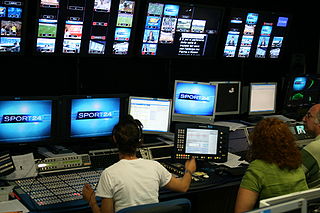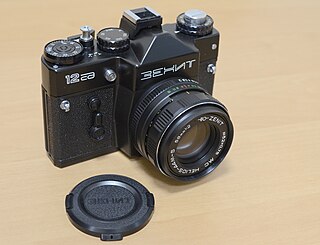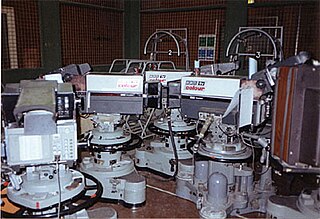
A single-lens reflex camera (SLR) is a camera that typically uses a mirror and prism system that permits the photographer to view through the lens and see exactly what will be captured. With twin lens reflex and rangefinder cameras, the viewed image could be significantly different from the final image. When the shutter button is pressed on most SLRs, the mirror flips out of the light path, allowing light to pass through to the light receptor and the image to be captured.

A camera is an instrument used to capture and store images and videos, either digitally via an electronic image sensor, or chemically via a light-sensitive material such as photographic film. As a pivotal technology in the fields of photography and videography, cameras have played a significant role in the progression of visual arts, media, entertainment, surveillance, and scientific research. The invention of the camera dates back to the 19th century and has since evolved with advancements in technology, leading to a vast array of types and models in the 21st century.
Genlock is a common technique where the video output of one source is used to synchronize other picture sources together. The aim in video applications is to ensure the coincidence of signals in time at a combining or switching point. When video instruments are synchronized in this way, they are said to be generator-locked, or genlocked.

A test card, also known as a test pattern or start-up/closedown test, is a television test signal, typically broadcast at times when the transmitter is active but no program is being broadcast.

A camcorder is a self-contained portable electronic device with video and recording as its primary function. It is typically equipped with an articulating screen mounted on the left side, a belt to facilitate holding on the right side, hot-swappable battery facing towards the user, hot-swappable recording media, and an internally contained quiet optical zoom lens.

A professional video camera is a high-end device for creating electronic moving images. Originally developed for use in television studios or with outside broadcast trucks, they are now also used for music videos, direct-to-video movies, corporate and educational videos, wedding videos, among other uses. Since the 2000s, most professional video cameras are digital.

Pebble Mill Studios was the BBC's television studio complex located in Edgbaston, Birmingham, England, United Kingdom, which served as the headquarters for BBC Birmingham from 1971 until 2004. The nine-acre site was opened by Princess Anne on 10 June 1971, and in addition to the studios contained two canteens, a post office, gardens, a seven-storey office block, and an outside broadcasting (OB) base.

A television studio, also called a television production studio, is an installation room in which video productions take place, either for the production of live television and its recording onto video tape or other media such as SSDs, or for the acquisition of raw footage for post-production. The design of a studio is similar to, and derived from, movie studios, with a few amendments for the special requirements of television production. A professional television studio generally has several rooms, which are kept separate for noise and practicality reasons. These rooms are connected via 'talkback' or an intercom, and personnel will be divided among these workplaces.

The production control room (PCR) or studio control room (SCR) is the place in a television studio in which the composition of the outgoing program takes place.

Zenit (Russian: Зени́т) is a Soviet camera brand manufactured by KMZ in the town of Krasnogorsk near Moscow since 1952 and by BelOMO in Belarus since the 1970s. The Zenit trademark is associated with 35 mm SLR cameras. Among related brands are Zorki (Watchful) for 35 mm rangefinder cameras, Moskva (Moscow) and Iskra (Spark) for medium-format folding cameras and Horizon for panoramic cameras. In the 1960s and 1970s, they were exported by Mashpriborintorg to 74 countries.

Pye Ltd was an electronics company founded in 1896 in Cambridge, England, as a manufacturer of scientific instruments. The company merged with EKCO in 1960. Philips of the Netherlands acquired a majority shareholding in 1967, and later gained full ownership.

The Philips circle pattern refers to a family of related electronically generated complex television station colour test cards. The content and layout of the original colour circle pattern was designed by Danish engineer Finn Hendil (1939–2011) in the Philips TV & Test Equipment laboratory in Amager near Copenhagen under supervision of chief engineer Erik Helmer Nielsen in 1966–67, largely building on their previous work with the monochrome PM5540 pattern. The first piece of equipment, the PM5544 colour pattern generator, which generates the pattern, was made by Finn Hendil and his group in 1968–69. The same team would also develop the Spanish TVE colour test card in 1973.
The 405-line monochrome analogue television broadcasting system was the first fully electronic television system to be used in regular broadcasting. The number of television lines influences the image resolution, or quality of the picture.
A video signal generator is a type of signal generator which outputs predetermined video and/or television oscillation waveforms, and other signals used in the synchronization of television devices and to stimulate faults in, or aid in parametric measurements of, television and video systems. There are several different types of video signal generators in widespread use. Regardless of the specific type, the output of a video generator will generally contain synchronization signals appropriate for television, including horizontal and vertical sync pulses or sync words. Generators of composite video signals will also include a colorburst signal as part of the output.
International Video Corporation, or IVC, was a California company with large European operations that manufactured a number of models of middle to high-end video tape recorders, or VTRs, for industrial and professional use in the US, alongside a range of digital video Time Base Correctors and Special Effects units designed and manufactured in the UK. Their products were very popular in the industrial, scientific, research, medical, education, and institutional markets from the late 1960s through the 1980s.
The Fernseh AG television company was registered in Berlin on July 3, 1929, by John Logie Baird, Robert Bosch, Zeiss Ikon and D.S. Loewe as partners. John Baird owned Baird Television Ltd. in London, Zeiss Ikon was a camera company in Dresden, D.S. Loewe owned a company in Berlin and Robert Bosch owned a company, Robert Bosch GmbH, in Stuttgart. with an initial capital of 100,000 Reichsmark. Fernseh AG did research and manufacturing of television equipment.

The 1/4 inch Akai is a portable helical scan EIA and CCIR analog recording video tape recorder (VTR) with two video record heads on the scanning drum. The units were available with an optional RF modulator to play back through a TV set, as well as a detachable video monitor. The Akai Electric Ltd. VTR plant was in Tokyo, Japan.

The EMI 2001 broadcast studio camera was an early, very successful British made Plumbicon studio camera that included the lens within the body of the camera. Four 30 mm tubes allowed one tube to be dedicated solely to producing a relatively high resolution monochrome signal, with the other three tubes each providing red, green and blue signals. Even though semiconductors were used in most of the camera, the highly sensitive head amplifiers still used thermionic valves in the first generation of the design.

A television production truck or OB van is a small mobile production control room to allow filming of events and video production at locations outside a regular television studio. They are used for remote broadcasts, outside broadcasting (OB), and electronic field production (EFP). Some require a crew of as many as 30 people, with additional trucks for additional equipment as well as a satellite truck, which transmits video back to the studio by sending it up through a communications satellite using a satellite dish, which then transmits it back down to the studio. Alternatively, some production trucks include a satellite transmitter and satellite dish for this purpose in a single truck body to save space, time and cost.
The four-tube television camera, intended for color television studio use, was first developed by RCA in the early 1960s. In this camera, in addition to the usual complement of three tubes for the red, green and blue images, a fourth tube was included to provide luminance detail of a scene. With such a camera, a sharp black and white picture was always assured, as it was not necessary to combine signals from the three colour tubes to provide the luminance detail.













